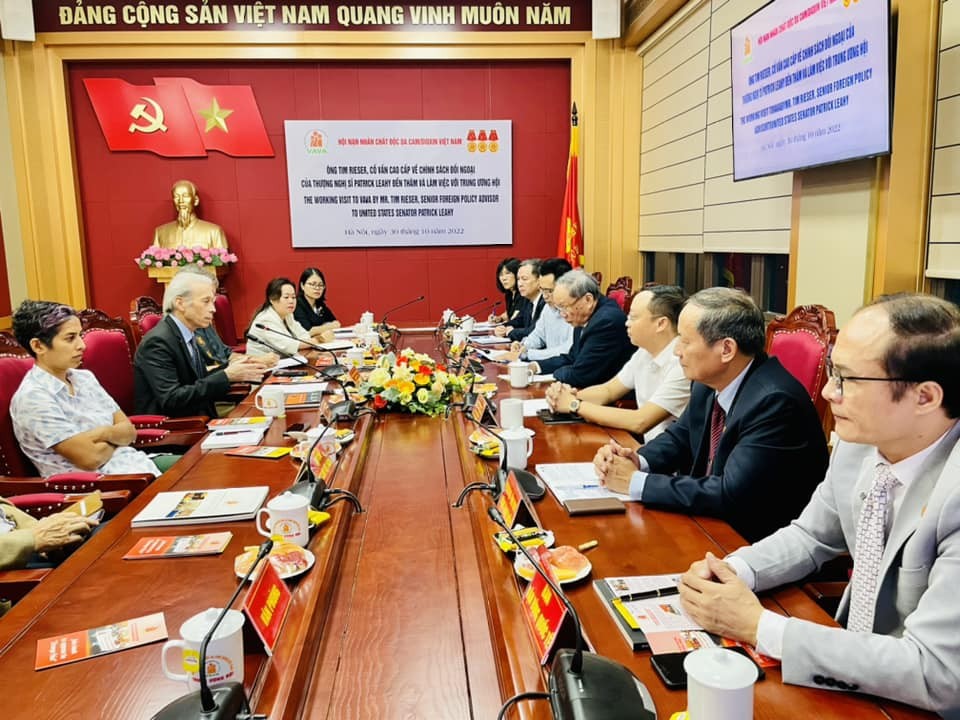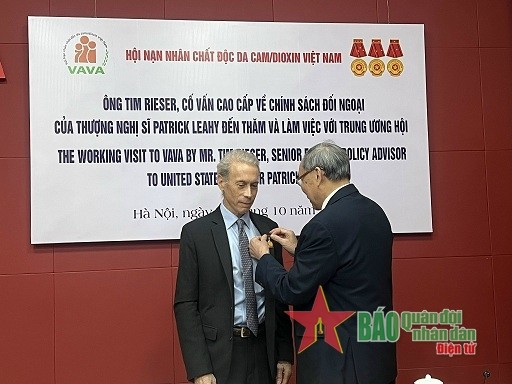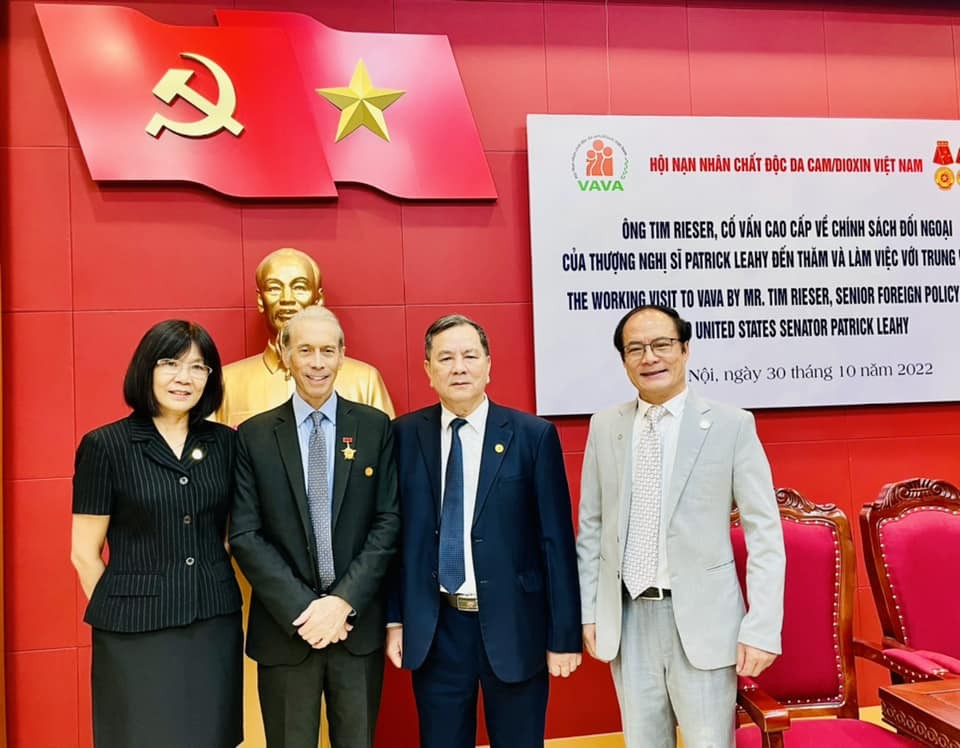Vietnam, US Overcome the Consequences of War Together
Sen Lieut. Gen. Nguyen Van Rinh, president of the Vietnam Association of Agent Orange/dioxin Victims (VAVA) has suggested the US form a long-term support programme inclusively for Agency Orange (AO) victims in Vietnam to enhance the effectiveness of US’s assistance relating to the settlement of war consequences.
 |
| At the event. Source: VAVA |
He made the suggestion at a reception for Tim Rieser, senior foreign policy advisor to US Senator Patrick Leahy, in Hanoi on October 30, reported VNA and PANO.
Over the past time, within the scope of support from the US Government, many people affected by AO still have not been able to access available support. The sources of support from the US are only aimed at beneficiaries who are people with disabilities in general, not for AO victims, and the projects supported by these grants are mainly focused on services or technical support for health care, training and employment counseling.
US support should be extended to many provinces and cities of Vietnam, with priority given to direct aid to victims’ families, Rinh said, adding that currently, the United States Agency for International Development (USAID) only supports 8 key provinces.
He spoke highly of Rieser’s contribution to promoting cooperation programmes in overcoming war consequences between the two countries, which he described as a bright spot in Vietnam-US relations.
The official also expressed his wish that Rieser would continue to direct the US Government and Congress’s attention to collaboration programmes on the settlement of war consequences in Vietnam and for AO victims.
 |
| The “For Agent Orange/Dioxin victims” insignia presented to Tim Rieser in recognition of his contributions to supporting AO victims. Source: PANO |
For his part, Tim Rieser affirmed that he will continue to advocate and push the US Government and Congress to pay attention and spend resources and budget for cooperation programs to overcome the consequences of the war in Vietnam.
He expressed agreement with the proposals of the VAVA President on focusing on supporting the victims severely affected by AO, improving the capacity and skills of the victims.
According to Rieser, in addition to overcoming post-war consequences and handling toxic chemical/dioxin contamination at Da Nang and Bien Hoa airports, the US side also plans to expand its support to many other provinces of Vietnam in the near future.
On the occasion, Rinh presented the “For Agent Orange/Dioxin victims” insignia to Rieser in recognition of his contributions to supporting AO victims.
According to VAVA, the US army sprayed 80 million litres of toxic chemicals on the south of Vietnam between 1961 and 1971, with 61% being AO containing 366kg of dioxin, on over nearly 3.06 million hectares (equivalent to nearly one quarter of the south’s total area).
Preliminary statistics showed that 4.8 million Vietnamese people were exposed to AO/dioxin, and about 3 million people became victims. Tens of thousands of people have died and millions of others suffered from cancer and other incurable diseases as a result. Many of their offsprings also suffer from birth deformities.
 |
| Delegates at the event. Source: VAVA |
Vietnam counts more than 150,000 second-generation AO victims, 35,000 of the third generation and 6,000 others of the fourth.
Since the VAVA establishment in January 2004, more than VND 2.66 trillion (nearly USD 113.7 million) has been donated to the Fund for AO Victims.
There are now 12 peace and friendship villages along with a number of nursing centres for disabled children, most of whom suffer from deformities caused by AO. The reproductive genetic counselling centres in Hanoi and Ho Chi Minh City have also been working actively to reduce the rate of babies with birth defects. Some localities have also conducted psychological trauma surveys and provided mental health assistance for AO victims.
Besides, VAVA has brought into play its role as the core force in fighting for justice for AO victims.
Since 2007, the US Congress has approved an annual budget for its country’s Government to help with the environmental remediation of dioxin contamination in Vietnam. The remediation was completed at Da Nang Airport in 2018 and then moved on to the Bien Hoa airbase.
The US Government also carried out a programme to support AO victims during 2016 – 2020 at a total cost of USD 21 million. Another programme worth USD 65 million for the 2021 – 2025 period is being promoted in some provinces hit hard by toxic chemicals during the war.
The post Vietnam, US Overcome the Consequences of War Together appeared first on Vietexplorer.com.
View more from VietExplorer:
The simple delights of a market tour in Quang BinhLan Ha Bay – a paradise on earth
Ta Nang – Phan Dung, a scenic trekking route
Travel companies ask for support due to increasing tour cancellations
Charcoal bread attracts customers in Quang Ninh
Lost on Kho Islet
Thua Thien-Hue adopts strict measures to keep tourists safe amid COVID-19
Kien Giang sees surge in tourist arrivals in July
Bluezone app: New weapon in fight against pandemic
Residents in Quang Ninh border province take quick COVID-19 tests
24 happy hours in Vietnam’s Phu Quoc Island
Vietnam nominated for multiple categories at the annual 2020 World Travel Awards
First human milk bank in northern Vietnam open
Vietnam photo among breathtaking artworks in world contest
A perfect day trip in Can Gio District
Promoting traditional cultural value of Vietnamese families
Visit the highest mountain in the southeastern region
Old wells bring vitality to villages
Postponing 2020 Olympics may become inevitable
Fast & Furious fare by the harbour
Comments
Post a Comment